TechRadar Verdict
Thanks to the combination of Samsung’s new ultra-bright, ultra-colourful QLED technology and some remarkable screen filtering, the Q8C’s pictures look amazing, even in a typical bright living room environment. That being said, those looking for the best screen for cinema-like dark rooms might want to look elsewhere.
Pros
- +
Bright, colorful pictures
- +
Beautiful design
- +
Good smart system
- +
Resilient to ambient light
Cons
- -
It’s relatively expensive
- -
Curved screen is divisive
- -
Some backlight banding
- -
Limited viewing angle
Why you can trust TechRadar
Samsung’s big TV story for 2017 is QLED televisions – which, in Samsung’s case, refers to TVs such as the Samsung Q8C that create their colours using Quantum Dots enclosed in a new metallic casing.
This enables them to be worked harder than normal Quantum Dots, so that they can stably output more brightness and a wider range of colours. All of which makes its new QLED sets potentially great friends to the high dynamic range and wide colour gamut technologies now making their mark in the AV world.
Samsung’s flagship Q9F QLED TV got the series off to a pretty dazzling start. But can QLED still make the grade on a much more affordable TV such as the Q8C?
- What is QLED TV, and why should you care?
- OLED vs QLED: battle of the TV panels
Design
Despite sharing the same QLED technology at its heart, the £3,000/$3,200 55-inch Q8C looks very different to its Q9F older brother. For starters, it’s got a curved screen, proving that Samsung hasn’t gone all flat on us just yet.
It’s also much slimmer, enjoys a lighter metallic frame finish, and sits airily on a pleasing silver bar-type desktop stand that deploys a gentle curve to match the shape of the screen.
While we personally hold a (potentially empathetic) flame for the chunkier design of the Q9F, the Q8C is undeniably better looking. And whatever your feelings about the quality pros and cons of a curved screen, there’s no doubt that it helps the Q8C to be one of the year’s prettiest TVs.
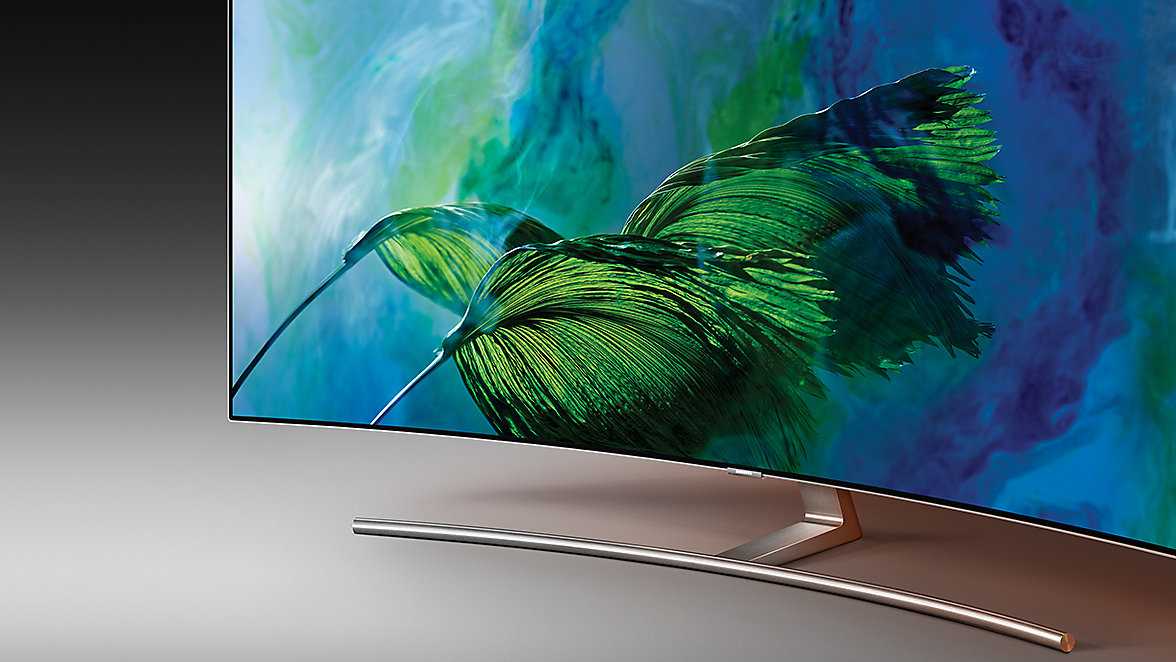
Screen sizes available: 55-inch, 65-inch, 75-inch | Tuner: Freeview HD | 4K: Yes | HDR: Yes | Panel technology: QLED with Edge LED lighting | Smart TV: Yes, Eden 2 (Tizen) | Curved: Yes | Dimensions: 1225.3 x 705.7 x 90.8mm (W x H x D) | 3D: No | Inputs: Four HDMIs, Three USBs, Wi-Fi, Ethernet
Sign up for breaking news, reviews, opinion, top tech deals, and more.
Design TL;DR: Samsung’s second QLED range swaps the monolithic slab approach of the Q9F range for a much more slender, much less imposing, likely much more popular curved design.
Smart TV (Eden 2, powered by Tizen)
After a few false starts over the years, Samsung is really starting to get the hang of this Smart TV thing. For starters, the Q8C boasts a brilliantly simple and effective voice control system that no longer requires you to learn a whole new way of talking or long sequences of commands – almost every feature on the TV (even some of the technical calibration tools) can be accessed and adjusted by just saying a couple of words.
As a result, the Q8C’s voice command system is the first one on a smart TV that we’ve used simply because we wanted to, rather than because we had to.
Admittedly, though, the latest iteration of Samsung’s Tizen-based Eden smart platform is more of an evolution from 2016 rather than a revolution.

But that’s fine, as it sees Samsung continuing to move steadily in the right direction with a two-layer icon system that delivers four of our favourite Smart interface elements: economical use of screen space; fast access to lots of content options; plenty of easy to achieve customisation; and speedy, slick response times. All in all, not a bad year for Tizen.
The many online services available through Eden include Amazon Video and Netflix (both with 4K and HDR support), plus the BBC iPlayer, ITV Player, All4 and My5 catch-up TV services for those living in the UK.
Smart TV TL;DR: Slick, no-nonsense menus, support for most of the key content providers and plenty of customisation options make the Q8C’s smart interface one of the best.
HD/SDR Performance
While the Q8C is literally made for HDR and 4K playback, it’s seriously accomplished with HD and standard dynamic range content, too.
Samsung's Q8C QLED screens actually lets you watch HD SDR content in two ways: using the content’s ‘native’ colour and brightness values, or ramped up to something approaching high dynamic range courtesy of Samsung’s HDR+ processing system.
In native form, SDR images combine outstanding black levels and beautifully detailed, natural colour tones. The impressively deep black levels are particularly gratifying considering we’re dealing here with a TV that uses edge-mounted LED lights to illuminate its pictures. It’s not just the depth of black colour that impresses, either; there’s also a very respectable amount of subtle light and colour detail retained in the darkest areas, and hardly any sign of the sort of backlight clouding or striping that so often affects edge lit TVs.

Colours stand out against the deep black foundation with real vibrancy and authority, and there’s so much subtle precision in the way colour blends and marginal tonal shifts are handled that you suddenly remember just how good SDR video can look when it’s done right.
Overall, the native SDR images look bright and full of contrast even without the HDR+ system in play, while Samsung’s HD-to-UHD upscaling system proves itself to be one of the best around.
That being said, the HDR+ feature for making SDR sources look like HDR won’t be to everyone’s taste, as it completely changes the luminance and colour values assigned to the source content when it was created. HDR+ is also easily the most aggressive HDR ‘upgrade’ system we’ve seen so far, in terms both of the amount of extra luminance it injects and the extent to which it expands the colour range. As a result it occasionally comes on too strong, causing issues such as a suddenly forced looking colour tone, an over-dominant peak white, or a short-lived burst of localised video noise. The HDR+ system can also cause some vertical light striping from the backlight around stand-out bright objects.
Despite all this, though, the results of HDR+ overall are impressive enough to persuade many Q8C owners to use it - at least when watching typical broadcast TV content.
HD/SDR Performance TL;DR: The Q8C is a seriously good HD/SDR performer, regardless of whether you use the HDR+ system or stick to your source’s native colour and brightness values.
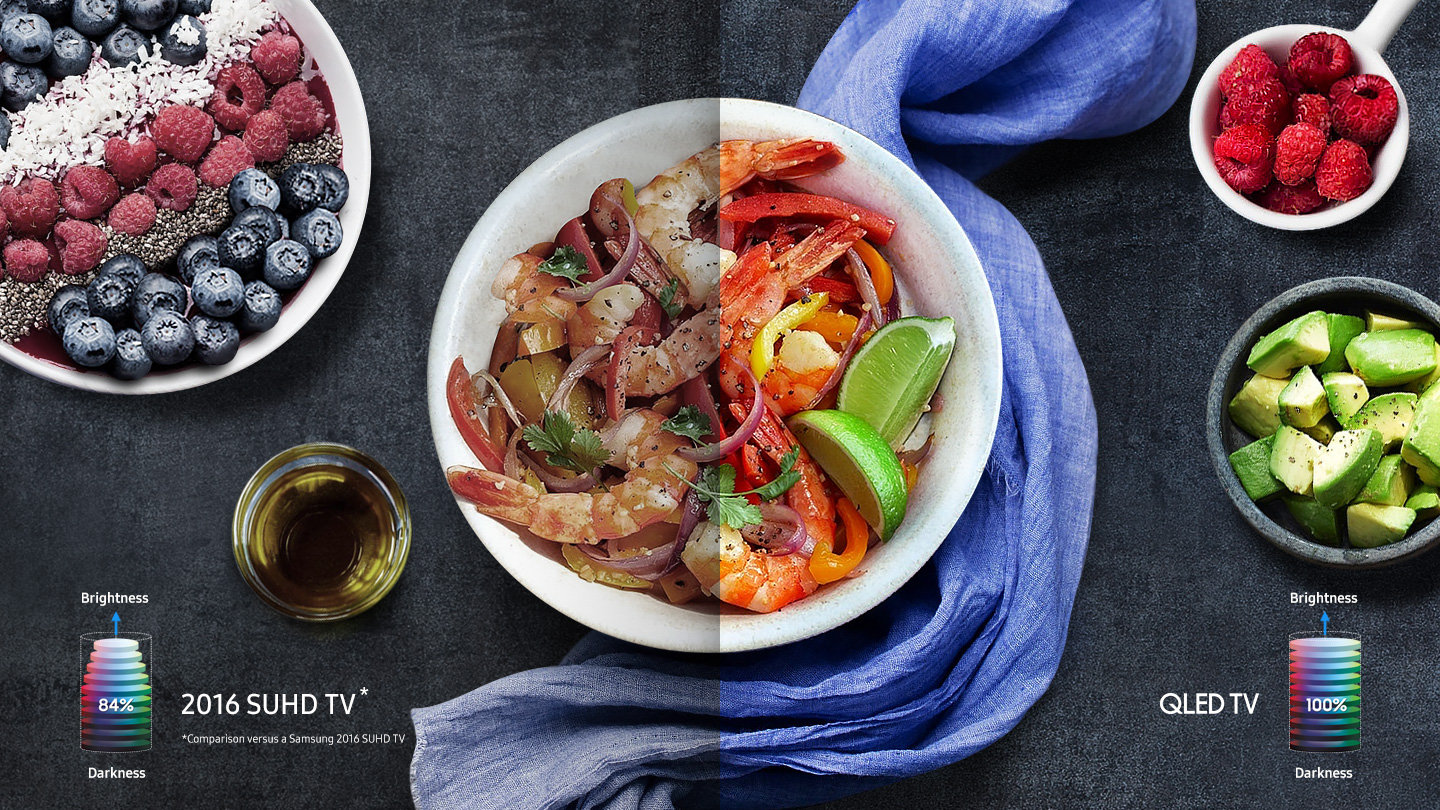
HDR/4K Performance
Given that QLED technology is designed first and foremost to deliver the HDR goods, it’s no great surprise to find the Q8C pumping out some seriously dramatic, intense HDR and wide colour gamut images.
The Q8C is reckoned to hit brightness peaks of around 1500 nits, which was backed up by our own measurements of around 1380 nits when playing a white HDR window that takes up 10% of the screen. This is around 500 nits lower than the maximum brightness of Samsung’s flagship Q9F TVs, but is still one of the highest brightness figures we’ve seen from the TV world to date.
With so much brightness to play with, the QE55Q8C excels at delivering the bright end of HDR’s expanded light range, producing images that truly radiate off the screen. And we mean this in an entirely positive way; it’s as if the brightness and light dynamics of the outside world are suddenly inside your TV too. Which is precisely the effect HDR is predominantly designed to create.
The Q8C’s armour-clad Quantum Dots together with some seemingly class-leading HDR tone mapping processing also ensure that the brightness is put to optimum use.
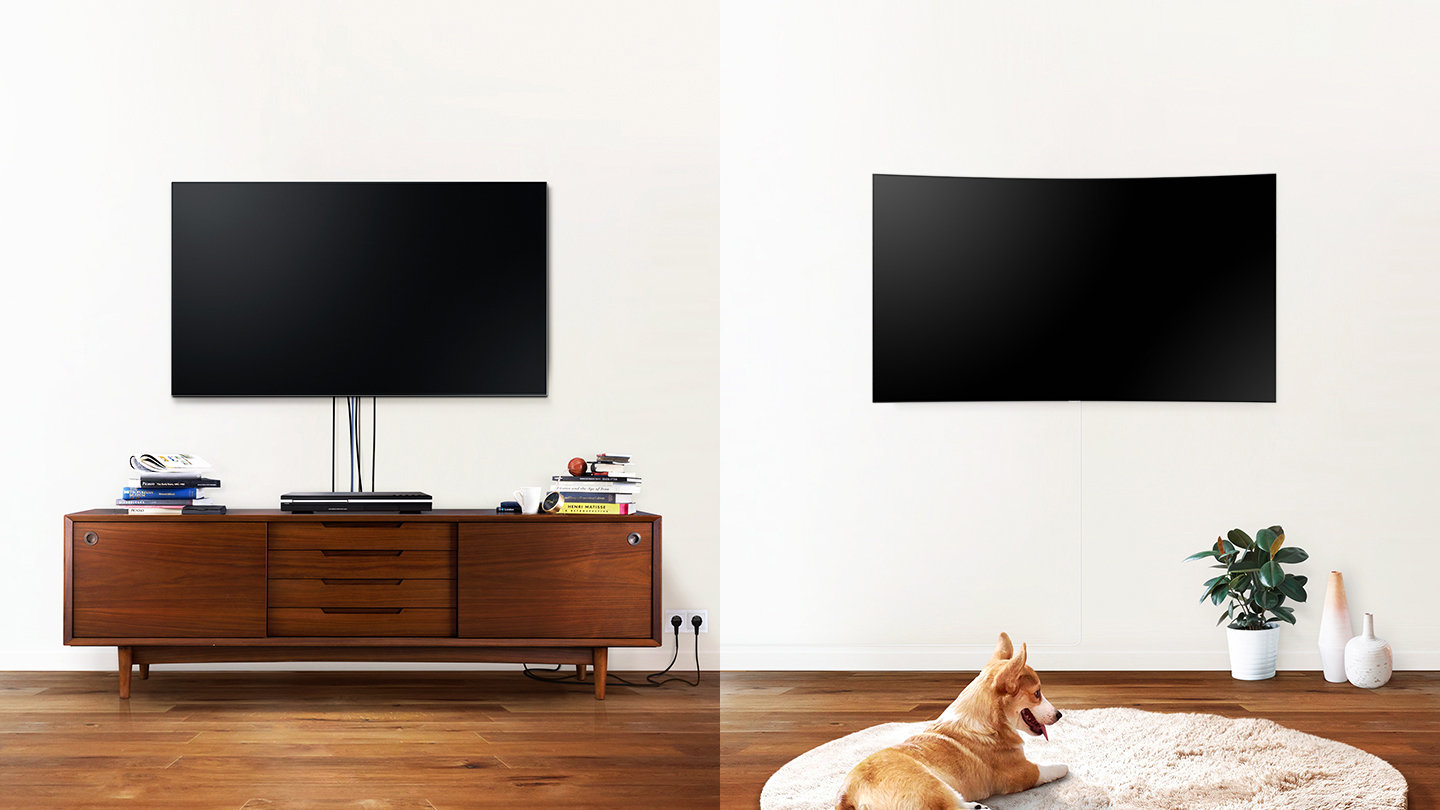
For instance, while the Q8C’s brightest image sections certainly are phenomenally punchy, they also retain plenty of subtle colour toning and detailing rather than ‘flaring out’ into empty white/bright colour holes as routinely happens with lesser HDR TVs. Having so much light behind them also helps the Q8C enjoy spectacular amounts of fine tonal detail with 4K HDR sources, even with dark tones that tend to flatten out with less potent screens.
It’s great to see, too, that Samsung has got much cleverer with its 2017 TVs at delivering lots of 4K-friendly sharpness and detail using its out-of-the-box settings without that sharpness being joined by noise or forced edging.
For sports fans and action aficionados, Samsung’s latest motion processing plays a part in the screen’s spectacular sharpness too, as it does a strong job - at least on its Clear or Custom settings - of keeping judder and blur interference to a minimum without causing unwanted side effects.
With HDR and 4K now becoming key parts of the gaming world, it’s pleasing to find the QE55Q8C suffering only 27ms of input lag (the time it takes to produce its pictures) when using its Game picture preset in either SDR or HDR mode. There are TVs out there that do even better than that, but it’s hard to imagine 27ms having a serious impact on anyone’s gaming skills.
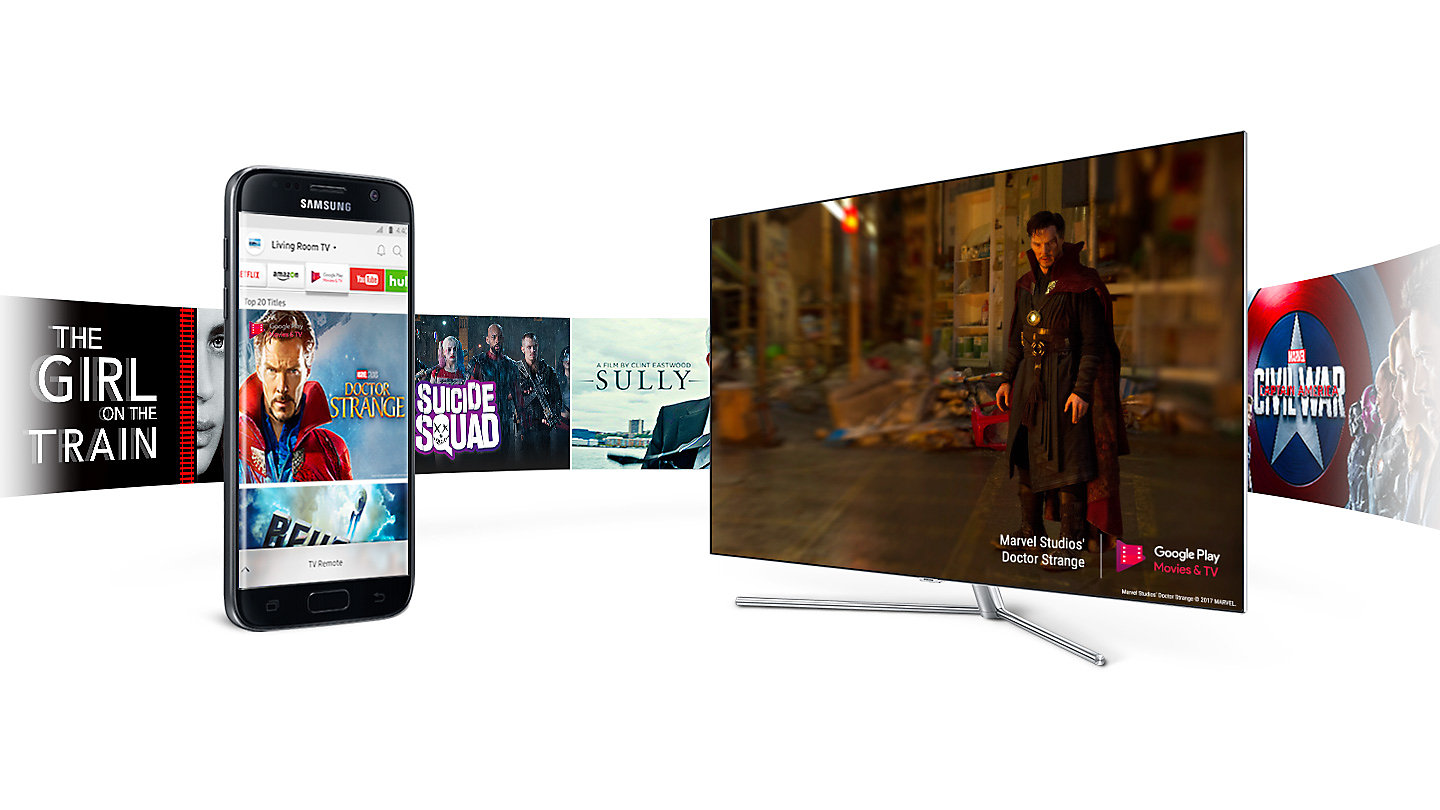
For all the QE55Q8C’s numerous picture strengths, though,the single most compelling one is the physics-defying way its pictures lose hardly any colour, contrast or brightness when you’re watching them in a bright room.
The Q8C’s curved screen means that its very minor reflections are stretched across more of the screen than they would be on the flat Q9F. But they’re still far less distracting than the sort of light-room reflections rival TVs suffer with.
This ambient light talent may not matter much to die-hard home cinema fans who only care about how a TV performs in a dark room, but it’s a potentially huge attraction for more casual users.
But what if you are a home cinema fan looking for a movie-like, dark-room experience from your next TV? You might want to skip the Q8C for one main reason: the appearance of vertical backlight stripes running right down the image when a very bright HDR object appears against a dark background.
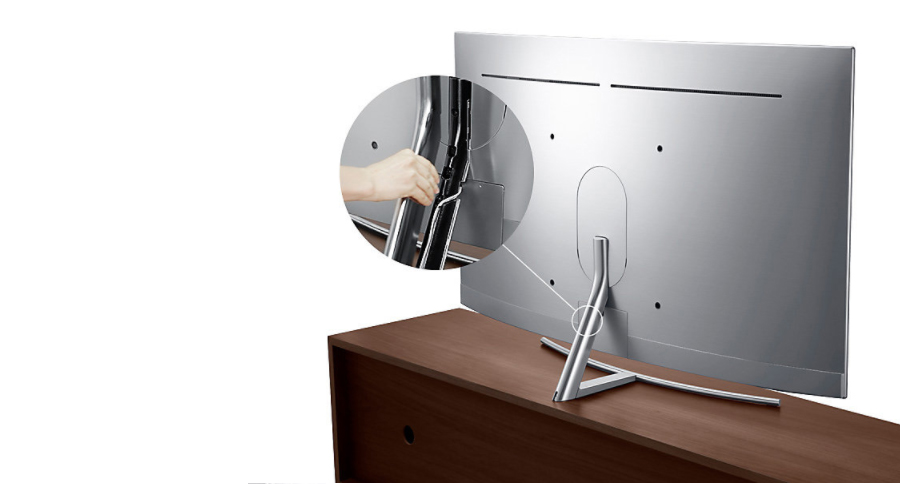
These stripes reduce greatly in intensity to the point where they pretty much disappear if you’re watching the Q8C in a bright room. But there’s no way to completely stop them being a distraction during HDR viewing in a dark room.
As well as sometimes being distracting in themselves, the backlight stripes can also cause colour tones behind them to look a little washed out.
HDR/4K performance TL;DR: Its stunning brightness and colour response make the Q8C an HDR star for the most part, while its screen filters make it uniquely watchable in a bright room. Home cinema fans, though, should note the appearance of backlight striping with dark HDR content when you’re watching the TV in a dark room.
Sound
The QE55Q8C’s slender design looks far too elegant to play host to anything so prosaic as speakers. However, cranking up its volume uncovers a surprisingly effective audio performance that combines an open-sounding mid-range with plenty of detailing and enough power to provide at least a sense of ebb and swell during action movie soundtracks.
A bit more bass would have sealed the deal, but the mid-range is expansive enough to ensure that the sound doesn’t become thin enough to be harsh.
Sound TL;DR: Although its audio won’t win any awards, it sounds better than we’d expected such a trim and good-looking TV to sound.
Other panels to ponder
The most direct rival to the Samsung QE55Q8C is the Sony KD-55XE9305 (or Sony XBR-55X930E in the US). This edge-lit set is actually slightly brighter, and looks as mesmerisingly sharp and detailed with 4K content. Its innovative slim backlight drive means it suffers with less backlight interference with HDR than the 55-inch Q8C, too - though Samsung’s QLED technology delivers a wider colour response and its pictures are much more resilient to ambient light.
Another option if you don’t mind trading brightness and colour volume for deeper blacks, better viewing angles and no backlight flaws would be LG’s OLED55B7 or OLED55C7 OLED TVs while Samsung’s step-up 65-inch QE65Q9F uses horizontal instead of vertical edge lighting, and so its backlight clouding issues are much less noticeable - despite it being 30% brighter.
Verdict
The way the Q8C’s combination of brightness and edge LED lighting can cause some backlight distractions during dark-room viewing means we can’t give it an unbridled recommendation. But its QLED approach to LCD technology delivers extremes of HDR-focused colour and brightness that hardly any other TVs can get close to, though, and it’s great with SDR too. By far its greatest strength is that it manages to hold on to the brilliance and contrast of its pictures in typical bright living room conditions better than any other 55-inch TV we’ve seen.
- Don't miss our round-up of the best TVs in 2017

John has been writing about home entertainment technology for more than two decades - an especially impressive feat considering he still claims to only be 35 years old (yeah, right). In that time he’s reviewed hundreds if not thousands of TVs, projectors and speakers, and spent frankly far too long sitting by himself in a dark room.
